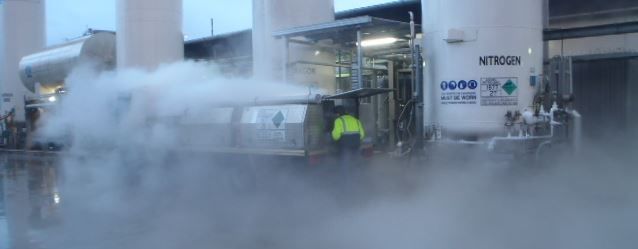Safe Environments were engaged by a gas a and liquid company to undertake noise testing of workers while they carried out the task of filling gas and liquid cylinders at the back of their truck. There were concerns that the noise while filling the gas cylinders were above the allowable noise exposure and to then also assess whether the hearing protection was sufficient to reduce the daily noise exposure to an acceptable limit.
The gases are stored in cylinders and large tanks on site and are distributed by trucks to clients. The trucks distribute liquid state products by being transferred from a large holding tank from the base site into smaller tanks located on either small or large trucks. This is done by each individual truck driver. The time taken to fill a vehicle vessel takes approximately 15 minutes. The small or large trucks then travel to site and transfer the liquids to a smaller container, “dewar”.
The majority of noise sources are from filling the vehicles with liquid nitrogen in the morning at the base site. Specifically the connecting and disconnecting of the hose as well as the release of compressed air.
The process of filling truck vessels may afford a risk of Noise Induced Hearing Loss if people are working within the filling area that measure noise pressure levels greater than 85 dB(A) averaged over an 8 hour day. The emphasis is to assess the risk of persons working for extended periods of time within these areas, assess whether signage and control measures such as personal hearing devices are required.
The preliminary noise assessment was conducted to AS 1269.1 Occupational Noise Management Part 1 Measurement and assessment of noise immission and exposure. The result of the preliminary noise testing was approximately 95.1 dB(A) with the task being conducted over a period of 15 minutes. Based on the noise and time this equates to a Pa2 hr of 0.32.
In simple terms, the noise exposure over the 15 minutes whilst filling the trucks accounts for one-third of their total daily noise exposure for an 8 hour day. Assuming that the workers are not exposed to other significant noise levels other than decanting the dewar, then the daily noise exposure would not likely be exceeded.
Subsequently, from these indicative readings, hearing protection is not required to ensure compliance with the Workplace Health and Safety Regulations, with a calculated LAeq,8 hr of 80. Hearing protection may be worn to assist in reducing discomfort to the truck drivers whilst filling; if they are to be worn, then Class 5 is considered to be excessive and no greater than Class 3 be provided.
This is to ensure that the truck drivers are not over-protected during the filling process which may be a safety issue in itself, by not being aware of their surroundings (i.e. approaching cars, trucks or forklifts).
In many instances, what may appear to be a hazardous noise, may only in fact be the perception of loud noise, particularly when people are exposed for a short period of time.
This is why a detailed noise assessment is required to be conducted in order to assess the risk. If people are exposed to significant noise levers then a noise management plan, hearing protection program and audiometric testing is recommended to manage the noise exposure adequately.
If you require a preliminary noise assessment or mobile audiometric testing, please contact Safe Environments in Sydney or Melbourne.
Author: Carl Strautins

Email: Carl@SafeEnvironments.com.au
Carl Strautins is a managing director of Safe Environments Pty Ltd a multi-specialist consultancy operating in the building, construction and property management industries. He provides the necessary guidance and risk minimisation strategies required by architects, construction companies and facility managers to ensure they mitigated their risk to property risk. He is engaged on a regular basis to provide expert opinion for disputes and legal proceedings. Click here to know more about him.


